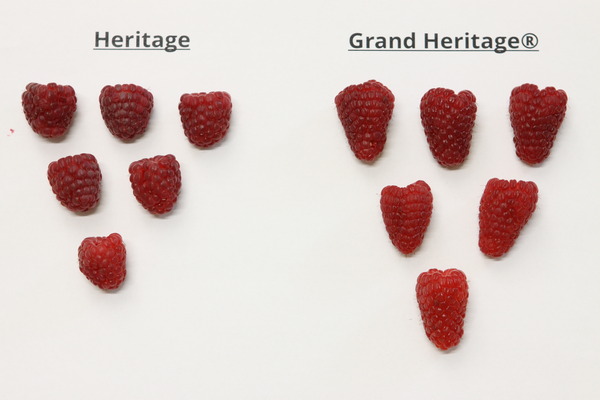What are the benefits of new varieties? What is the difference between the new varieties? Is it worth cultivating new raspberry varieties? These are the questions we often hear. But instead of talking until we are blue in the face, we'll simply show you a picture:

Picture: ‘Heritage’ (1969) vs. ‘Grand Heritage’ (2024)
Which variety would you want to plant?
‘Heritage’ (1969)
It was 1969 and I was just six years old. But I had nothing to do with raspberries yet, except to steal the best fruit from my mum's raspberry row...
The ‘Heritage’ raspberry variety was released in 1969. Bred at Cornell University, New York, by Dr Waldo, it quickly established itself on the market: it is also suitable for hotter climates, has an upright growth habit, branches well and had the best yield potential of all autumn raspberry varieties in the 1960s/70s. The ‘Heritage’ variety retained its strong position even when ‘Autumn Bliss’, the new raspberry star, appeared over ten years later. Both varieties combine good, relatively early ripening, upright, well-branched growth, reasonable fruit size and an acceptable flavour. Here is a botanical detail, by the way: the early autumn raspberry breeding at Cornell became very successful due to wild early ripening autumn raspberry populations discovered in New York State, which probably belong to the American subspecies Rubus strigosus.
‘Grand Heritage’ (2024)
The year is 2024 and the raspberries have grown larger – what am I saying – they are twice as big. The weight of a ‘Grand Heritage’ raspberry is eight to nine grams, a far cry from the four grams of the previous variety. There are 55 years between the two varieties, four to five breeding generations. The new ‘Heritage’ is also easy to produce; it has fewer thorns and is among the best varieties in most characteristics. ‘Grand Heritage’ is just waiting to become a new standard variety. It reliably starts ripening at the end of July, which is slightly earlier than ‘Heritage’.
The moral of the 'story'
We could tell the same or a similar story about almost all old varieties compared to the new varieties. It is simply even clearer here due to the similarity in name and positioning. And we sell infinitely large quantities of the old varieties, around 300,000 of ‘Heritage’. These questions remain: can we afford to continue selling old varieties indefinitely when there are already much better ones? And how long will it be before the rumour spreads, precisely because it is true: the raspberries in the supermarket are said to be much bigger and better than those in the garden...?
